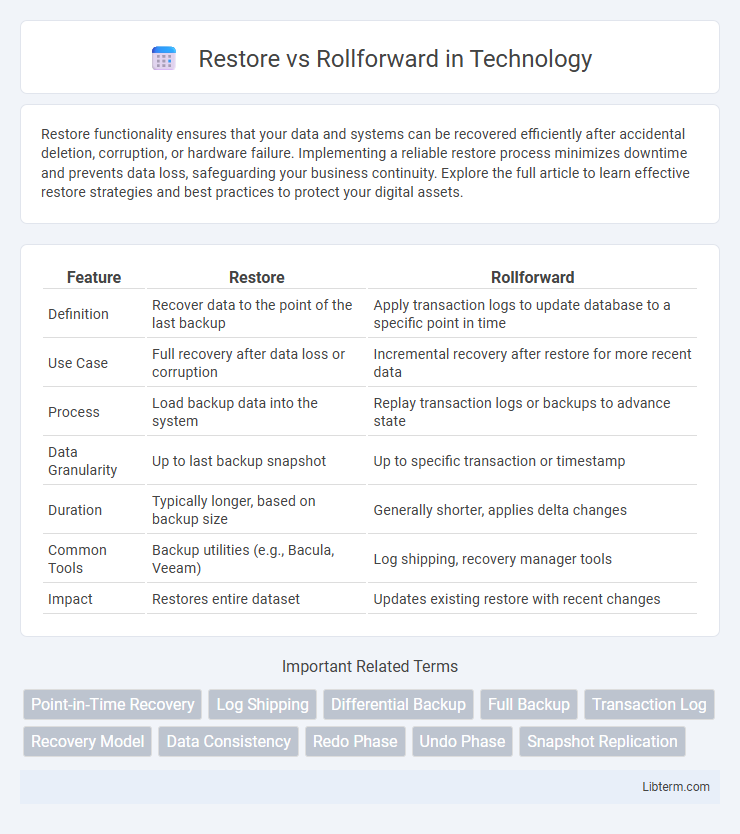Restore functionality ensures that your data and systems can be recovered efficiently after accidental deletion, corruption, or hardware failure. Implementing a reliable restore process minimizes downtime and prevents data loss, safeguarding your business continuity. Explore the full article to learn effective restore strategies and best practices to protect your digital assets.
Table of Comparison
| Feature | Restore | Rollforward |
|---|---|---|
| Definition | Recover data to the point of the last backup | Apply transaction logs to update database to a specific point in time |
| Use Case | Full recovery after data loss or corruption | Incremental recovery after restore for more recent data |
| Process | Load backup data into the system | Replay transaction logs or backups to advance state |
| Data Granularity | Up to last backup snapshot | Up to specific transaction or timestamp |
| Duration | Typically longer, based on backup size | Generally shorter, applies delta changes |
| Common Tools | Backup utilities (e.g., Bacula, Veeam) | Log shipping, recovery manager tools |
| Impact | Restores entire dataset | Updates existing restore with recent changes |
Understanding Restore and Rollforward
Restore involves retrieving data from a backup to revert a database to a specific point in time, ensuring data consistency and recovery after failures. Rollforward applies transaction logs or archive logs to the restored backup, updating the database to a more current state by applying committed transactions. Understanding restore and rollforward processes is critical for effective database recovery strategies and minimizing data loss.
Key Differences Between Restore and Rollforward
Restore involves recovering data from backup files to a previous state, effectively replacing the current database with the backed-up version. Rollforward applies transaction logs after a restore to bring the database up to a specific point in time, ensuring data consistency and minimizing data loss. The key difference lies in restore reestablishing the baseline database, while rollforward updates it incrementally using transaction logs.
When to Use Restore Operations
Restore operations are essential when recovering a database to a specific point-in-time after data loss or corruption, requiring the application of backup files to replace the current state. Use restore procedures when initiating recovery from full, differential, or transaction log backups to rebuild the database to a consistent state. This process is critical in disaster recovery scenarios where complete restoration from backup sets is necessary before continuing with rollforward recovery steps.
Best Scenarios for Rollforward Usage
Rollforward is best used in scenarios requiring database recovery after a crash or unexpected failure to apply committed transactions recorded in the log since the last backup. This method efficiently restores data integrity by replaying transaction logs, minimizing data loss and downtime. Rollforward is ideal when consistent backups exist, and only incremental changes need to be updated to recover the latest database state.
Step-by-Step Guide to Database Restore
Performing a database restore involves retrieving data from a backup file to return the database to a previous state, ensuring data integrity and continuity. The step-by-step guide typically includes selecting the appropriate backup file, using database management tools or commands such as RESTORE DATABASE in SQL Server or pg_restore for PostgreSQL, and verifying the restored data. Rollforward, or transaction log restore, is applied after the initial restore to replay transaction logs, bringing the database to a specific point in time beyond the backup snapshot.
How Rollforward Works in Data Recovery
Rollforward in data recovery works by applying transaction logs to a restored database backup, bringing it to the most current state before failure. This process replays committed transactions recorded after the backup, ensuring no data is lost between the backup time and the failure event. By systematically processing log records, rollforward enables precise recovery to a specific point in time, minimizing data inconsistencies and downtime.
Restore vs Rollforward: Performance Impact
Restore operations involve loading a complete backup image, resulting in significant disk I/O and longer recovery times compared to rollforward, which applies only transaction logs to bring the database to a specific point in time. Rollforward actions consume fewer resources by incrementally updating the database, thereby offering faster recovery and minimizing system downtime. Optimizing rollforward performance depends on efficient log management and storage speed, making it preferable for scenarios requiring minimal performance impact during recovery.
Common Challenges and Solutions
Restore and Rollforward operations frequently encounter challenges such as data inconsistency, prolonged downtime, and incomplete transaction logs during recovery processes. Common solutions involve implementing incremental backups, ensuring transaction log integrity, and using point-in-time recovery techniques to minimize data loss and expedite system restoration. Automated validation tools and robust backup strategies further address issues related to data corruption and synchronization gaps.
Best Practices for Restore and Rollforward
Best practices for restore and rollforward emphasize ensuring data consistency and minimizing downtime. Perform regular backups and verify backup integrity before initiating a restore to avoid data loss. During rollforward, apply transaction logs sequentially and monitor for errors to maintain database integrity and ensure successful recovery to the desired state.
Choosing the Right Recovery Method
Selecting the appropriate recovery method between restore and rollforward depends on the extent of data loss and system downtime tolerance. Restore is ideal for complete system failures requiring a full database recovery from backup media, while rollforward is suited for applying transaction logs after a restore to bring the database to a specific point in time. Effective disaster recovery planning integrates both methods to minimize data loss and ensure rapid service restoration.
Restore Infographic

 libterm.com
libterm.com